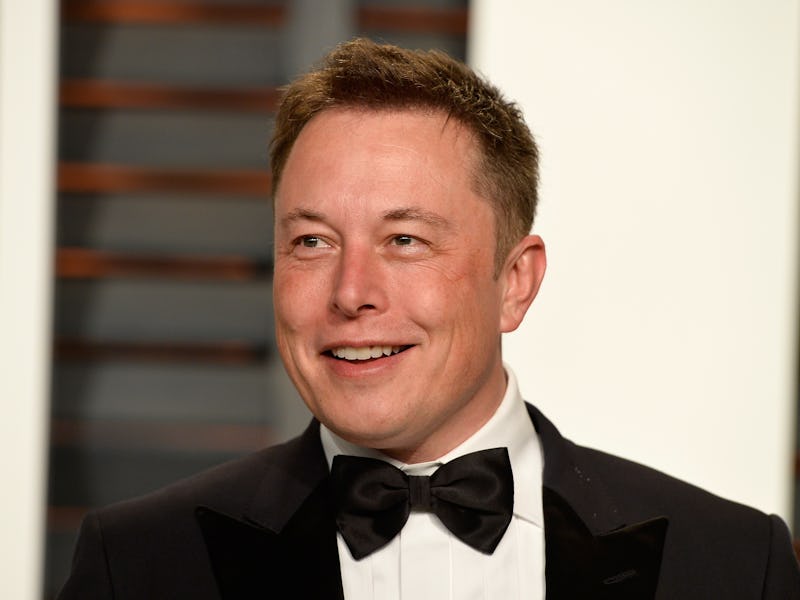
For a while now, Elon Musk has been hinting that brain-machine interfaces are his pick for the next big innovation to unlock human potential. In particular, he’s recently teased his interest in a technology called neural lace.
Now the Wall Street Journal reports that he’s behind a startup called Neuralink. After the story’s publication, Musk confirmed the existence of the company on Twitter, and revealed that a longer story about Neuralink would appear on explainer website WaitButWhy in a week. While current details are scarce, what is known is enough to make anybody’s imagination run wild.
He’s talking about neural lace, the brain implant that connects anyone’s mind to the cloud to create super-intelligence humans.
Neuralink is a biotech company registered in California, and it’s looking to develop neural lace technology into something that could actually hit the market for consumers. It’s already been tested in mice — though Musk may find that getting approval for human testing, let alone sale, of an invasive medical device makes getting approval for space launch look trivial.
Neuralink has already hired a number of top experts in the fields of flexible electrodes and brain physiology, though at this early stage the company is still taking its funding entirely from Musk himself.
In January, Musk hinted he was working on something, but he wouldn’t say what:
The company’s initial focus will, astutely, be pure medical applications like diagnosis and even treatment brain conditions. Neural lace could snuff out the storms of electrical activity that cause epileptic seizures, and it could greatly reduce the side-effects of the controversial electroconvulsive therapy for depression.
If successful, this will not only help cast the technology in a positive light, but present ethics boards with a real early reason to push past the risks of initial human testing. Once we’ve had human beings walking around for years with neural lace implants, regardless of why they got those implants in the first place, it will be much easier to pitch expansion of the procedure for other aims.
Musk’s aims for this technology are clear: The control of A.I. and robots with mental commands, for increases in both the speed and usefulness of interactions with A.I.
Musk seems to believe that this melding of human and machine is necessary to help mankind keep pace with the expansion of A.I. and robotics, recently claiming that A.I. has the potential to turn humanity into a species of “house cats” subservient to mechanical tenders. This is in line with Musk’s thinking about doomsday A.I., which came out again in an interview published Sunday in Vanity Fair.
[Musk] said that the way to escape human obsolescence, in the end, may be by “having some sort of merger of biological intelligence and machine intelligence.” This Vulcan mind-meld could involve something called a neural lace—an injectable mesh that would literally hardwire your brain to communicate directly with computers. “We’re already cyborgs,” Musk told me in February. “Your phone and your computer are extensions of you, but the interface is through finger movements or speech, which are very slow.” With a neural lace inside your skull you would flash data from your brain, wirelessly, to your digital devices or to virtually unlimited computing power in the cloud. “For a meaningful partial-brain interface, I think we’re roughly four or five years away.”
The neural lace prosthesis is small and flexible enough to be injected with a syringe — it will reach the brain via the jugular, apparently, and sit outside the brain with the dreaded “blood-brain barrier” still lying between it and the neurons it is supposed to read. This means it has a lower maximum level of fidelity than real brain implants, which involve actually putting something into the brain directly, but much higher than exterior “skullcaps” that have to read neurons through the skull.
Neural Lace Faces Skepticism
However, the public is sensitive to the idea of technology invading its thought processes — just ask Mark Zuckerberg, who has been accused of attempted mind control for nothing more invasive than algorithmic post-sorting. Neuralink is reportedly open to investment in the future by Peter Thiel’s Founder’s Fund, a venture capital fund that also has its fingers in everything from AirBnB to the controversial Palantir. Some of the same people who see the potential in using big data to track people for the government also see potential in literally reading people’s minds — or, at least, their brains. Possible abuse of this technology will be a major topic of discussion.
It should be. We know very little about this technology right now, and likely won’t see learn much more for a while, but this is a technology that seems every bit as much in need of caution as A.I. itself. If a neural lace prosthesis can offset a seizure, in all likelihood it could also produce one if it sent the wrong sets of stimulating impulses. If it can perform even mild ECG shocks, it can cause muscle contractions that could interfere with people’s movements.
If neural lace continues ongoing research to pick up thought-based commands from specific areas of the brain, and translate those commands to manipulate a computer interface, it could potentially notice and identify other simple, repeated thoughts as well.
It’s not so crazy to imagine neural mesh picking up simple repeated thoughts like obsessions, or even passwords.
Update 3/28 6 a.m. Eastern: After this story’s publication, Elon Musk confirmed Neuralink’s existence on his Twitter account. The story has been updated to reflect this.